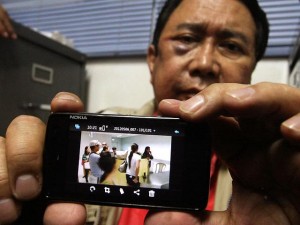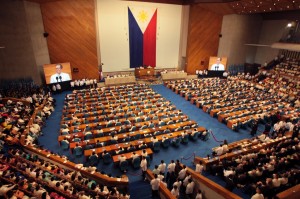Mon Tulfo says that Raymart punched him first. Raymart says that he was retaliating from a previous kick… yada yada… I’m sure you all know about what happened because this incident was Inquirer’s headline last Monday. Currently, it’s the most important national issue (not the RH Bill, or the Freedom of Information Bill, or the hypocrisy the Roman Catholic hierarchy) and it affects all of us, Filipinos.
There is, however, divided opinion on who started the fight, since both parties have accused each other of instigating the brawl. It is in these crucial situations of National importance that each Filipino citizen must re-evaluate his or her notion of truth in order to ultimately determine which side of the story (Team Tulfo or Team Barreto/Santiago) he or she ultimately believes. In this essay we will examine several theories of truth and how they each apply to this incident:
1. The Correspondence Theory of Truth

According to Wikipedia, which is the most reliable source of information in the universe, this theory of truth “states that the truth or falsity of a statement is determined only by how it relates to the world and whether it accurately describes (i.e., corresponds with) that world.”
This theory, of course, implies that there is an objective reality and that individuals have the ability to perceive that reality objectively.
Unfortunately, this theory of truth is proven useless by the NAIA incident, because, as statements from both parties clearly demonstrate, objective reality doesn’t exist. Mon Tulfo and Barreto/Santiago have perceived different versions of reality.
In Mon’s version of reality, Raymart tried to confiscate his phone and that Raymart punched him after he refused to surrender it. In Barreto/Santiago’s version of reality, Claudine was first karate-kicked by Mon and Raymart retaliated by punching him.
Given the discrepancy between their statements, the public might be tempted to conclude that at least one of the parties is lying. But doing so would be to oversimplify the nature of truth.
2. The Constructivist Theory of Truth

Another theory of truth suggests that truth is a synthetic or “man-made,” invented and established through social power struggles. As it says in the ultimate source of information, Wikipedia, “Social constructivism holds that truth is constructed by social processes, is historically and culturally specific, and that it is in part shaped through the power struggles within a community.”
There is an objective world that we come in contact with. However, we interpret information differently. Our modes of interpretation are influenced by different factors such as convention, human perception, and social experience.
Needless to say, when Claudine allegedly threw a bitch fit and cursed at the airport crew, she sincerely thought that she was within her rights to behave in such a manner. Her assumptions and expectations do not mirror those of regular people because she comes from a culture and an environment where such feelings of entitlement may be the convention.
3. Nietzsche’s Perspectivism

The constructivist view of truth is a little similar to Nietzsche’s concept of perspectivism. In “The Will to Power” Nietzsche says, “It is our needs that interpret the world; our drives and their For and Against. Every drive is a kind of lust to rule; each one has its perspective that it would like to compel all the other drives to accept as a norm.”
To simplify, what this means is that truth is simply the reflection of the desires of those in power. Truth is a power struggle and those who win the struggle can decide what the truth is.
When I was teaching, the example I liked to use was how the concept of “late” was defined in my class. My class started at 9:00 am. I asked my students what it meant to be “late.” They said that coming to class after 9:00 am meant that they were late. Then, I asked them, “What if you arrived at 9:15 and I arrived at 9:20? Would you still be late?”
This example may be an extreme oversimplification of the idea, but it is a very clear example of the political nature of truth. Those who are in power make up the rules; they make up the truth.

The “The Thrilla in NAIA” presents an interesting example because the people involved (the Barettos, Santiagos, and Tulfos) have some level of influence and power that allows them to cleverly maneuver their perspectives of the truth and try to win the confidence of the public.
Paraphrasing Nietzsche’s quote, “Each one has its perspective that it would like to compel all the other drives to accept as a norm”:
Each party, the Tulfos & the Santiago/Barretos, has its own version of the truth that it would like to compel the public to accept as the norm.
Here’s a question then: If these people are so influential, why is public opinion so important to them?
That brings us to the next theory, the consensus theory.
4. The Consensus Theory of Truth

According to the most plagiarized website by college students, Wikipedia, “Consensus theory holds that truth is whatever is agreed upon, or in some versions, might come to be agreed upon, by some specified group. Such a group might include all human beings, or a subset thereof consisting of more than one person.”
Just in case you missed the important bit, here it is:
“TRUTH IS WHATEVER IS AGREED UPON.”
To simplify, if the general consensus, the public opinion is that you have an ugly face, that is how you will be perceived and treated regardless of how much your face adheres to the principles of aesthetics.

Think of the “The Thrilla in NAIA” as a nationwide survey. Be careful how you cast your opinion though, because the resolution of this conflict has long-term consequences that will affect our progress as a nation for many years to come.
Our opinions have the power to compel other drives, create ideas that can shift social focus towards worthy agendas. It’s only fitting that we devote ample time and effort towards the propagation of celebrity gossip.
The consequences of celebrity behavior require more in-depth analysis, more study and more discussion, because it is through the deep reflection of these incidents that we learn and discover our cultural identity as Filipinos, and as human beings.
Credits:
The term “Thrilla in NAIA” as well as the fake poster photo was borrowed from here: http://tunaynalalake.blogspot.com/2012/05/tunay-na-lalake-royal-rumble.html


The most important revelations here is that NAIA 3 has broken CCTV camera and weak security enforcement. I guess the php200 addition to the terminal fee was either insufficient or plainly stolen.
Unfortunately, I'm guessing it's the latter.